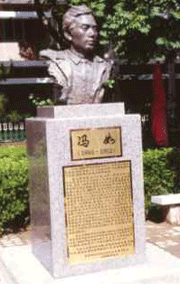E-Archive
Off the Beaten Track
in Vol. 8 - November Issue - Year 2007
A REAL CELESTIAL FLYER

The monument to Feng Ru is foung on the campus of the Beihang University
“Run, quick, get out, get out!” The earthquake struck with incredible violence, with no tremors to forewarn of the impending disaster. There was a loud cracking sound from the ceiling as Feng Ru scooped up his baby brother from the floor and dashed towards the door of the small, modest home, the rest of his family right on his heels. Just as single drops of rain form a trickle, which quickly turns into a stream, which then grows into a mighty river, so the frightened mass of humanity increased in number at every junction until it flowed through the narrow lanes of Chinatown with an unstoppable power of its own. Feng Ru did not slow down until he reached the safety of the surrounding fields, where he finally collapsed on the grass, his lungs heaving furiously. Somehow, his family had managed to keep together and they now stared incredulously into each others’ faces, turning to look behind them, where they could see the first wisps of smoke from the fires which would complete the destruction of all that the earthquake had already flattened.
***********
Feng Ru was born in 1883 and emigrated to the United States with his parents when he was twelve years old. They lived and worked in various parts of California until finally settling down in San Francisco, where the young boy labored during the day to help support his family and attended English classes in the evening. He developed a strong interest in mechanics and electricity, soon learning how to design and build electric motors and setting up a wireless telegraph at home. The news of the Wright brothers’ first powered flight fired his imagination and he became totally absorbed by the nascent field of aeronautics.
The Great Earthquake of 1906 forced the family to move to Oakland, where Feng Ru continued his studies and fantasized about constructing his own aircraft. His project drew the support of the local Chinese community, which financed the establishment of the “Canton Airplane Factory” in a small wooden shed not far from his home. In 1908 he built his first aircraft and even manufactured his own engine, but lost everything in the fire that started when he crashed into his own workshop during his first test flight.
By the middle of the following year, he had built a new airplane, which he called “Feng Ru No. 1”. It was a biplane with a wingspan of twenty-five feet driven by a six horsepower engine. More prudently this time, he brought it to the Piedmont hills outside Oakland for testing. With the help of Chung Doo Nam, a Chinese restaurant owner who was also one of his financial backers, Feng Ru assembled the plane and, in the late afternoon of Tuesday, the 21st of September 1909, finally pushed the throttle forward. The airplane rose from the ground and responded well to Feng Ru’s commands as he followed the contour of the hilly ground. As a precaution, Feng Ru kept an altitude of not more than ten or twelve feet, but the flight lasted a full twenty minutes and the airplane proved its stability as it completed a full circle despite the presence of a strong wind. As the plane was about to begin a second circuit, a bolt holding the propeller broke and the craft nosedived to the ground, leaving Feng Ru bruised but otherwise unscathed. The test was deemed a huge success and attracted even more investors among the Chinese community in Oakland. According to a newspaper report at that time, Feng Ru would “proceed to build a stronger and more powerful craft with which he plans to show the Cantonese of his native China a real Celestial flyer.”
Feng Ru continued to work on his drawings and built a “Feng Ru No. 2”, which he flew for forty minutes in January 1911, achieving perfect control and stability. The Chinese government, which had been following his work with keen interest, encouraged Feng Ru to go to China to demonstrate his aircraft and his skills. After a sumptuous farewell banquet attended by a good part of Chinatown, Feng Ru loaded two of his airplanes on a steamer and left. While in his native country, he organized aviation shows and in March 1912 manufactured the very first airplane to be built in China. Unfortunately his brilliant story came to a tragic end when he was killed during a demonstration flight in Canton on August 25th, 1912.
By Giovanni Gregorat, Contributing Editor MFN & Sales Manager, Pometon Abrasives
Author: Giovanni Gregorat



























